
|   |

|   |
Bhoopaala Bharatham: History lesson, dance and mime (Part 2) Text & pics: Lalitha Venkat e-mail: lalvenkat@yahoo.com August 7, 2013 The 17th edition of the annual week long Bharatanatyam festival (July 28 to August 2) organized by Natyarangam, the dance wing of Narada Gana Sabha in Chennai, was titled Bhoopaala Bharatham (Kings as protectors of the land and people). Link to part 1 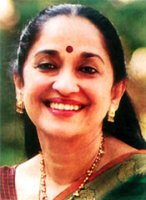 Dr. Nandita Krishna Day 4: Dr. Nandita Krishna elaborated on the lives of the Travancore royals MARTHANDA VARMA and SWATI THIRUNAL with a few slides. Anizham Thirunal Marthanda Varma was king of Travancore from 1729 till his death in 1758. He ascended the throne of Venadu in 1729 when he was in his early twenties, and organized an army of 50,000 soldiers. He was not only a shrewd tactician and king but an able general as well. He annexed several neighboring states and contributed to the expansion of Travancore, establishing it as a powerful military state in southern India. Travancore under Marthanda Varma was one of the few kingdoms in India that consolidated its power by the use of maritime outlets. He built roads, public buildings, rest houses, dams, framed an annual budget and patronized the arts. Several great writers and poets adorned his court. He renovated temples all over the state. 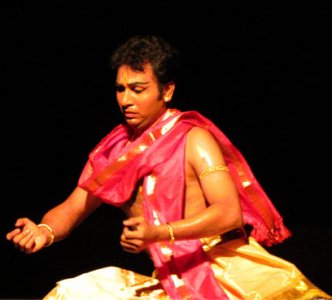 Shijith Nambiar  Parvathy Menon The recital started with a short signature tune of Bhoopaala Bharatham (that echoed through the music score) before Shijith Nambiar and Parvathy Menon entered the stage clad in beautiful costumes in typical Kerala colors of cream and gold. The invocation was dedicated to the Lord of Ananthapuri. Marthanda Varma is distraught at the several misdeeds he had to commit to stay in power. Overcome with emotions, he calls out to Lord Padmanabha who appears before him and asks him the reason for his discontent. Marthanda Varma confesses his love for his cousin Ummini Thanka with whom he had grown up. Their lives were intertwined from birth and he had promised to marry her on his coronation. Since her brothers were after the kingdom and were conspiring to kill him, he was forced to kill them in battle in order to protect the land of Padmanabha. When Marthanda Varma went with all preparations to marry Ummini Thanka, she extracted her revenge by pulling out her tongue and committing suicide. The story was depicted with romance and drama in a judicious mix of nritta and abhinaya sequences. A shattered Marthanda Varma asks Lord Padmanabha why his beloved had committed such an act; he had done no wrong as he had after all killed his relatives only for the good of the kingdom. The Lord tells him that he’s a valorous man and protector of the people but he unfortunately was not entitled to the fruit of his actions. “Never consider yourself to be the cause of the results of your activities, and never be attached to not doing your duty. You are the protector of your people. They look up to you for their well-being and prosperity. You are the valorous Marthanda Varma.” The story was well portrayed and using only forceful jathis for war sequences accompanied by chenda/edakka was very effective. 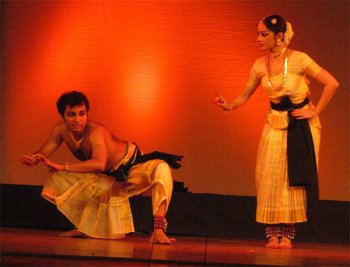 Shijith & Parvathy
Marthanda Varma built dams. He even assembled a courageous army that
fought against and defeated the Dutch at the famous Kulachal Yudham in
1741. This is one of the first instances of an Indian state defeating a
European power in war. The 20 Dutch prisoners were treated with
kindness, so they were glad to take service under the Maharaja. He
renovated the Padmanabhaswamy temple in Thiruvananthapuram, made it the
capital of Travancore in 1745 and dedicated his kingdom to Lord
Padmanabha in 1750. After that he was called Padmanabha Dasa and ruled
the kingdom as the servant of that deity. Travancore thus became the
property of Lord Padmanabha (God’s own country). Marthanda Varma’s sword
with which he proclaimed himself to be a servant of Lord Padmanabha is
still preserved in the Padmanabhapuram palace. A short piece was
performed in praise of the king. Just before his death, he summoned his nephew and successor and instructed him that all rituals and ceremonies in the Padmanabhaswamy temple were to be continued for all time, the kingdom with its land and people should forever be the possession of the deity. Lord Padmanabha appears in human form to Marthanda Varma saying he will appear yuga after yuga whenever there is adharma. Varma is pacified on seeing the Lord’s human form and says, “I am restored to my original nature. Now, I completely surrender myself to you. Lead me to my salvation.” To this, the Lord says, “O Marthanda Varma, whenever and wherever there is a decline in religious practice, and a predominant rise of irreligion, at that time I appear myself. In order to deliver the pious, annihilate the miscreants, and to re-establish the principles of religion, I will appear millennium after millennium.” Hearing this divine assertion, Varma completely surrenders himself to the deity and becomes one with him. Wearing a long garland around her neck transformed Parvathy into Padmanabha. Very effective lighting and soulful music enhanced this scene. Two decades later, Swathi Thirunal was born. He was proficient in 18 languages and could write and compose poetry in most of them. He established the first English school, an observatory and music college. He fought against corruption and wanted to project Travancore as a model state. He was the first ruler to introduce allopathy. He collected and transcribed rare manuscripts, established a printing press. He was a compassionate ruler, a great composer and music enthusiast. He compiled a Grammar of Malayalam and an English-Malayalam Dictionary. He composed 200 kirtanas in Sanskrit, several dance compositions in Malayalam and 38 songs in Hindustani. Eminent musicians adorned his court. The Thanjavur Quartette spent some time in Thiruvananthapuram. Vadivelu and Swati Thirunal composed music and dance compositions together and introduced violin in Carnatic music. Swati Thirunal is believed to have developed Mohiniattam, even designing its costume and composed several padas and padavarnas in Malayalam. He maintained a Hindustani dance group of 8 artistes. His was the golden age in the 19th century. The birth of Swati Thirunal was depicted by Parvathy emoting to “Omanathingal” that was composed by poet Irayimman Thampi on the birth of the royal baby. His mother encouraged his interest in music and dance. One day, a devadasi from Thanjavur named Sugandavalli comes to his court. He’s enthralled by her beauty and takes her as his third wife. The romantic scenes worked well for the husband-wife duo. Swati Thirunal abolished the ‘satyapariksha’ ordeal by Nambudri women accused of adultery having to prove their innocence by dipping their fingers in boiling ghee. This and his lavishing support on artistes and musicians were dramatized followed by an excerpt from “Shankara sri giri.” The love between Swati Tirunal and Sugandhavalli deepens, and with it, so does his prodigious artistic output. But seeing the amount of money lavished on the arts, the British are outraged. They commence a ruthless campaign by which they target the citizens of Travancore and kill them for no reason. At this juncture, natural disasters strike the kingdom causing significant loss of life and property. Swati Tirunal is depressed that he is unable to protect his subjects. Unable to bear the responsibility of being a dasa of Lord Padmanabha, he goes to the temple and surrenders his crown and sword at the Lord’s feet. He goes to sleep, never to wake up again. All that remained was the glowing lamp of wisdom and the lingering peals of his musical legacy. This was portrayed poignantly by Shijith, aided by the haunting music and deft lighting. The brilliant orchestra members also clad in Kerala colors were Arun Gopinath on vocal, Venkatasubramaniam on mridangam, JB Sruti Sagar on flute, Girish Madhu on nattuvangam, Suresh on chenda and edakka, Tanvi Kamath on tampura. Music was composed by Edapalli Ajith Kumar. The recital was marked with intelligent choreography, wonderful music and good lighting, but the first half could have done with some editing. Shijith and Parvathy being husband and wife, their chemistry worked very well on stage, leaving the audience wondering how it would have worked out if one of them had been teamed with another dancer. Shijith Nambiar shares his thought process on the theme and choreography. “As an artiste, this year’s topic has given me a wonderful experience. The title Bhoopala Bharatham attracted me so much that I used the title as theme music for our performance. It was nice to hear people humming the title music when they left the auditorium after our performance. When we look back, both Parvathy and I felt as though we were living through the lives of Marthanda Varma and Swathi Tirunal. As though we were communicating with them and now it feels like a dream. We enjoyed each and every process of bringing these two kings to life. After a number of ideas and viewpoints, we finally decided on having Sri Padmanabha as the hero after a visit to the Padmanabhaswamy temple in Thiruvananthapuram. The whole process of choreography started after offering pranams to Sri Padmanabha. He was the guardian of the royal state of Travancore, our hero and we narrated the story using him as the central figure - the actual Bhoopala of Thiruvananthapuram. We didn’t want to do two different stories depicting two Bhoopalas. After a lot of thought processing on how to develop the story, we finally came up with the idea of Marthanda Varma and Swathi Thirunal as two avatarams of Sri Padmanabha. Mahavishnu says, “Whenever there is a decline in Dharma, I shall emerge.” Similarly, Sri Padmanabha sends Marthanda Varma and Swathi Thirunal as his dasas to protect the people of Travancore. We consider it as a blessing to have got such an idea and from there the story just flowed and fell in place. Our resource person Nanditha Krishna gave us all the freedom in the development of the story and the choreography. As soon as I landed from the US, we had a long conversation, but we didn’t have a structure. After meeting her, I went to Thiruvananthapuram to meet relevant people and collected countless materials regarding the subject. My visit to Ananthapuri was worth all the effort. Both our Bhoopalas were Padmanabha dasas and yet they were different. While Marthanda Varma was a Karma yogi, Swathi Tirunal was a bhaktha. Marthanda Varma was an embodiment of valour while Swathi Tirunal was filled with compassion. Both were able administrators. As partners in dance as well as in life, Parvathy and I had certain plus points. We had already developed a good chemistry through our performance career. We didn’t have to fix a particular time for our practice as we could work whenever we were free, even if it was 12 midnight! That was our advantage. Bhoopaala Bharatam’s extraordinary music created by Edappally Ajith Kumar, brought out the traditional Kerala essence of Sopana sangeetham and Kathakali sangeetham into the music which was our biggest strength and breathtaking singing by Arun Gopinath. We were fortunate to have a wonderful team of accompaniments. We are still lost in that realm!”  V Sriram Day 5: August 1 was dedicated to SHAHAJI AND SARABHOJI, the Maratha rulers of Thanjavur, and introduced succinctly by V Sriram. The world of fine arts owes a great deal to the Thanjavur region. Eight rulers ascended the throne after Ekoji and all were great patrons of the arts. Shahaji II, Ekoji II and Sarabhoji II were composers while Sarabhoji I and Tulaja I were musicologists. They embellished the local culture with their own heritage. During Tulaja’s time, the trinity of Carnatic music was born. The music of the Marathas gave us the art form of Harikatha. Shahaji II known as Abhinava Bhoja surrounded himself with poets, composers and scholars. A great composer, he composed 22 operas of which the music of only Sankara Pallaki Seva Prabandha is available. He composed several songs in praise of Thiruvarur Thyagesa. While most of his compositions are in Telugu, his Thyagaraja Vinoda Chitra Prabandha in manipravala demonstrates his mastery over several languages. 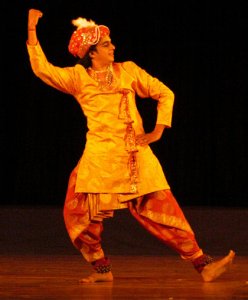 Madhusudanan 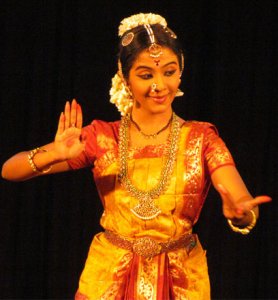 Prithvija After an invocation from the Pallaki Seva Prabandha, under the gaze of a life sized model of Shahaji (wonder where they managed to get that!), KB Madhusudanan and Prithvija dramatized the glory of the Brihadeeswara temple, using spoken dialogue and gestures. An excerpt from Pallaki Seva Prabandha was performed. Set in Tiruvarur, Kamalamba (goddess Parvati) pines for her beloved Tyagaraja (Shiva). Seeing Tyagaraja seated in court in all his splendor, the sakhis are speechless. To send as messenger of love, the moon is considered as having no character, the snake as a split-tongued creature and the deer as not qualified. Madhu transformed himself into all these while Prithvija played the lovelorn Kamalamba. Finally, the sakhis go themselves and deliver the message. Tyagaraja accedes and goes by palanquin to take the goddess with him. They enjoy a meal and after much merriment in the form of music and dance, retire to the bedchamber for the night. It was a fairly straightforward representation of the story, with a quick change of attire by Madhusudan, who wore a tunic and a turban that we see in the representations of the king.  Madhusudanan & Prithvija
Part two was about Sarabhoji. An adopted son, he got well versed in the arts and dedicated himself to the arts. A multi-faceted personality, he studied ophthalmology, the human body, human diseases, birds, animals. He encouraged women to teach. He experimented with art forms. He brought western music and introduced violin and clarinet into Carnatic music. Europeans were brought in to teach western music. He hoarded manuscripts and put them in Saraswati Mahal Library where they exist well preserved to this day. About his travel from Thanjavur to Benaras, he wrote a travelogue Tristhaliyatra Lavani in dance form. He created songs in Marathi for the Bharatanatyam margam being perfected by his court musicians, the Thanjavur Quartet. He encouraged the use of folk music in classical dance and the art form of Bhagavathamela. Once again spoken dialogues and gestures depicted the importance of Saraswati Mahal Library and some aspects of the king’s story followed by a short charming sequence of the ‘poikkalkudhirai’ or dummy horse folk dance that was introduced to Tamilnadu by Serfoji. The recital concluded with a thillana where Madhusudhan was again clad in a tunic and a different turban as suitable to Serfoji. The music ensemble was Hariprasad on vocal (he also composed some parts of it), Girish Madhu on nattuvangam, Koteeswaran on tabla, Sruti Sagar on flute, Vedakrishnaram on mridangam and Srividya on veena. Instead of wearing an ill fitting tunic and those cumbersome turbans that slightly hindered his performance, Madhu could have stuck to his regular costume and avoided that strained look about his shoulders. Both Madhu and Prithvija are good dancers but as a team they did not click. The recital was slow moving at times, picking up energy in the thillana. “When I got a call from Natyarangam to take part in Bhoopaala Bharatham, I had no idea who my co-dancer was. After a couple of days, I came to know that it was Prithvija. We met our resource person Mr. Sriram, who gave us a couple of books and details about the kings and their work. We then met Sudha Seshayyan who gave us a lot more information about the theme after which I conceptualized the scenes with Prithvija, selected the songs and gave it to Hariprasad for composing. Initially it was little difficult to start the choreography. I went to collect some details from Anna Library and got few seppedugal, but that was no use for composing. The difficult part was to explain everything to my co-dancer because she couldn’t read Tamil. We got the music for thillana and mangalam just a week before the show. I consider this as a great experience to execute these kinds of themes,” says Madhusudhanan.  Vikram Sampath Day 6: “All the arts we know of today have their origins in the past. A dynasty that fits the bill is the Wodeyar dynasty.” It was a grand finale to Bhoopaala Bharatham with a knowledgeable talk by Vikram Sampath, a perfect choice since he has authored a book on the WODEYARS OF MYSORE whose reign spanned 600 years. This was followed by a sparkling interpretation in dance of the historical and cultural heritage of Mysore by Sathyanarayana Raju and Lakshmi Gopalaswamy from Bangalore in a neatly structured sequence covering many kings. The first image of Mysore that comes to mind is the Dussehra procession where the Goddess Chamundi is brought on the ambari on Vijayadasami day. By using the kolattam, cymbals and so on, the dancers depicted the music entourage. 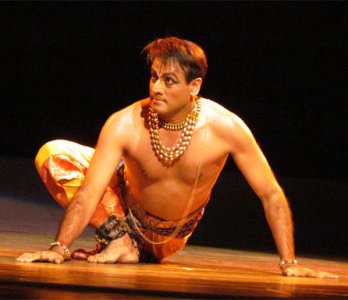 Sathyanarayana Raju 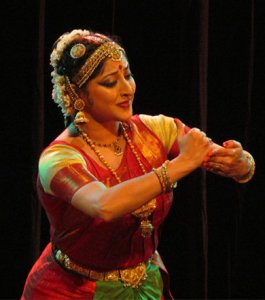 Lakshmi Gopalaswamy Around 1399 AD, directed by his dreams, Yaduraya, a young aspirant from Dwaraka, goes to Mahishuru (that had lost its chieftain to the cunning Maaranayaka), to pay obeisance to Goddess Chamundi. He spends the night at a small temple of Kodi Bhairava and overhears 2 women talking about the death of the king and the evil plan of the minister to usurp the kingdom and take away the princess. On waking, he finds a sword. Taking it to be a divine decree, he kills Maaranayaka, marries the princess and becomes the first Wodeyar or chieftain of 33 villages. Sathya introduced Yaduraya in a nritta piece and Lakshmi appeared as Chamundi. Moving to the 17th century to the great period of Ranadheera Kanthirava (1638-73), Sathyanarayana as Ranadheera showed his wrestling prowess by flexing his muscles and establishing his valour. He then single handedly defeated the 25 wrestlers who were sent by the chieftain of Trichirapalli to assassinate him. Jathis were used effectively to depict the encounter. It was an energetic solo elegantly performed, followed by an expressive piece by the duo. Ranadheera was an able administrator who introduced the system of coinage for the first time in Mysore with the seal of Varaha. He built a dam over the river Koundini. A patron of the arts, he allotted separate streets for musicians and a stretch of land for a dance school outside Srirangapatna. The dancers used a verse from Govinda Vaidya’s Kanteerava Narasimha Raja Vijayam to describe his court filled with vainikas and surrounded by enchanting music. 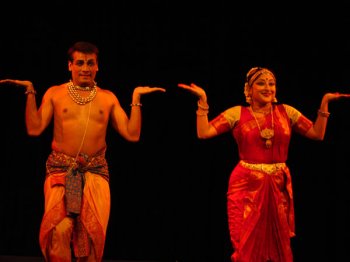 Sathyanarayana Raju & Lakshmi Gopalaswamy
Chikkadevaraja, the nephew of Ranadheera’s successor Doddadevaraja (who built the 1000 steps leading up Chamundi hill and the big bull), was called Navakoti Narayana and under his reign Mysore saw its golden era. His bravery even caught the attention of Mughal ruler Aurangazeb. An ardent devotee of Lord Cheluvanarayana of Melkote, he authored Chikkadevaraya Binnappam from which a verse was used. The Mysore style of Bharatanatyam originated under him. A rare shloka in salutation to the goddess of the stage (Range Devate) was followed by jathis in the Mysore style of Bharatanatyam. Sathya appeared in royal tunic and turban as the king Chikkadevaraja who sits back to enjoy the recital of the dancer and rewards her for her performance. Lakshmi was at her vivacious best as she presented the traditional Mysore jathigalu in the Mysore style of Bharatanatyam specially taught to her by Bangalore based gurus Bhanumathi and Sheela Chandrasekhar. The salaams in the item were absolutely enchanting! After a spell under Hyder Ali and Tippu Sultan, Mysore came under the rule of Mummadi Krishnaraja Wodeyar, who authored several books. A fan of javalis, he had eminent musicians in his court. The Mysore style of painting originated under him. In his treatise Srithathvanidhi, ragas and talas are depicted as humans. Mysore developed its own style of veena playing and separate streets were named after vainikas. Mummadi was also a great patron of Yakshagana. “The one who rules the world, the light of Mahishuru, well versed in arts and sports, the rising moon amidst the sea of people whose emblem is the gandaberuda. We salute Karnataka’s Divya Ratna Mummadi Krishnaraja Wodeyar.” The gandaberuda is a 2 headed bird symbolizing justice and vigilance, so that one is awake while the other one rests. This was a brief piece in which the dancers’ depiction of gandaberuda was effective. It was followed by a lively javali by Mysore Sadashiva Rao in raga Atana performed charmingly by Lakshmi. “Where are you, handsome one? When even munis cannot withstand the arrows of moha, how can a mere mortal like me escape the torment of Manmatha? Oh Krishnarajendra, why this stubbornness?” Chamaraja Wodeyar realized the importance of women’s education and started the first school for girls. Music was a compulsory part of the curriculum. The dancers presented a thillana by Veena Seshanna. This was followed by Sathya’s graceful solo in a javali written by Veena Padmanabhayya where the hero Chamarajendra is trying to woo his heroine. After enduring her persistent coy glances, he says, “Enough of those silent messages. Just come to me!” The golden age of Wodeyars during the reign of Nalwadi Krishnarajendra Wodeyar that lasted almost 50 years was likened by Mahatma Gandhi to Rama raajya. Nalwadi empowered women with voting rights and built the engineering marvel Krishnarajasagar Dam for which he and his mother Kempanajammani pledged their personal jewels as the budget had overshot its limit. He was proficient in playing 8 instruments and patronized all styles of classical music. The dancers highlighted these aspects through the popular daru “Maathe malayadwaja” by Muthiah Bhagavathar. Jayachamarajendra Wodeyar was an accomplished composer and pianist and had more than 90 compositions to his credit with the pen name of ‘Srividya.’ His composition “Sri Jaalandara” was presented in Gambhiranattai, followed by the Mysore anthem “Kaayo sri Gowri” composed in 1881 by Basavappa Shastri and set to tune with the help of the Maharaja’s band master. It is believed to have inspired Rabindranath Tagore to compose our national anthem. The orchestra managed to achieve a western band music tone. The dancers were quick in using minor costume changes for character depiction and there was no lag between sequences. Brief introductions between sequences helped the audience. In the solos, Sathya lived up to his reputation of being one of India’s best male dancers, but in the duet pieces, it seemed as if he stepped back and let Lakshmi shine. Lakshmi’s joy in performing was clearly reflected in her inspired dance. She was so animated and bubbly throughout. The wonderful orchestra members were D Srivatsa on vocal, Soundarya Srivatsa on nattuvangam, Harsha Samaga on mridangam, Nataraja Murthy on violin and Mahesh Swamy on flute. So what were the challenges? “The challenges were many. First of all we had to study the details of every Wodeyar and it took a lot of time. Lakshmi was really fantastic. She took time off from her film shooting, did a lot of research and selected songs from all the composers. She's very well read and knowledgeable in music. For me, it was great opportunity to work with Lakshmi. With the help of scholars like Vikram Sampath, Karthik, Srikanta Nagendra Shastry and Dr. Uma Gopalaswamy, we put our presentation together. More than the difficulty, it was fun to work on this project and collect information about the Wodeyars,” says Sathyanarayana Raju. The accompanying artistes on all evenings filled the hall with their wonderful music. The stars on all days were the resource persons whose talks were much appreciated by one and all. While it is good to convey the message that all resource persons and performers are fantabulous people, reading out lengthy bios before the resource person spoke, and more lengthy bios of the dancers before the performance, some read out badly, tested one’s patience. Also, many wondered why some dancers were being repeated when there is such an abundance of talented Bharatanatyam artistes. It was announced that the book on Bhoopaala Bharatham with articles by the resource persons would be available for Rs.20, but not even one copy was spotted anywhere. On the fourth day, we discovered that it was available at the Narada Gana Sabha office where the staff gingerly brought out a few copies to give us. When asked why they had not put them out for sale, they said they did not want people to throw away the copies. Why would anyone buy these books and then throw them? Since we did not see anyone having these copies for reference, perhaps all the printed copies are stored safe and sound in the office! Lalitha Venkat is the content editor of narthaki.com |